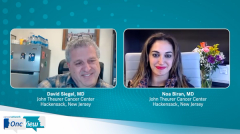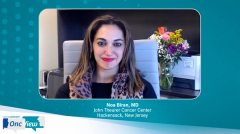
Evolving Treatment Paradigms in Multiple Myeloma
Noa Biran, MD, and David Siegel, MD, review the shifting treatment paradigms in multiple myeloma (MM).
Episodes in this series

Transcript:
Noa Biran, MD: Good Morning. My name is Noa Biran, I’m one of the multiple myeloma [MM] physicians here at the John Theurer Cancer Center [in Hackensack, New Jersey].
David Siegel, MD: And I’m David Siegel, I’m one of the older MM physicians at the John Theurer Cancer Center.
Noa Biran, MD: David, it would be nice to hear your perspective since you’ve been doing this for quite some time on how the paradigms have changed in the treatment of patients with MM.
David Siegel, MD: I’ve been taking care of patients with myeloma probably [since] 1990, which is when I started to center on myeloma. When I used to talk about myeloma back then, the median survival for a patient who required therapy was measured in months—18 months was the median survival. Today, we’re probably closer to 18 years than we are to 18 months. The big evolution in the time that I’ve been practicing was peripheral blood stem cell transplants, so high-dose melphalan. We have patients who do extraordinarily well for extremely long periods of time with that. Nothing has really pushed that to the side yet. But once we got through the stem cell transplants, we had relatively little that worked for extended periods of time.
Now our dilemma is that we have so many things that are active that our problem is what order do you do things, what combinations do you do? The list of possibilities continues to get longer. I think we have the ability to at least clinically cure some patients already, patients who will not die from myeloma. And that wasn’t the case. I think that number of patients continues to get larger and larger. But we still have a disease that generally beats us, and that’s what we have to fix.
Noa Biran, MD: Where do you see a role for us to make the biggest difference in our patients’ lives? What are the unmet needs?
David Siegel, MD: An unmet need is that excellent young people come into the field and not be daunted. Obviously, we have that here in Hackensack [John Theurer Cancer Center]. We have you. We have other young people who are going to carry the torch. But continuing with the technological advances and the familiarity with the disease, [because] we call a lot of stuff myeloma. There are 2 things that have to happen. We have to understand the different brands of myeloma. We used to call almost all lymphomas, intermediate grade lymphomas. In fact, lymphoma is 50 different diseases that we understand the biology of and we treat differently. In myeloma, we haven’t gotten to that point.
One of the very important things we have to do is continue to study the disease itself, understand what the drivers are, and start to target the disease based on that. The other part of it is the continued advancement in terms of platforms. What everybody’s talking about today are CAR [chimeric antigen receptor] T cells and other T-cell diverting therapies. The most popular one right now is what we call T-cell engagers. We’re going to continue to develop better therapies, and most importantly I think, start matching those therapies to the patients who are most likely to gain from them. That’s the exciting thing. Noa’s in the middle of [studying] it. Most of the clinical trials we’re running here right now are Noa’s inventions, and Noa’s handling them. She can speak to what new things we’re doing perhaps as well as or better than I can.
Transcript edited for clarity.
Newsletter
Stay up to date on recent advances in the multidisciplinary approach to cancer.


























































































